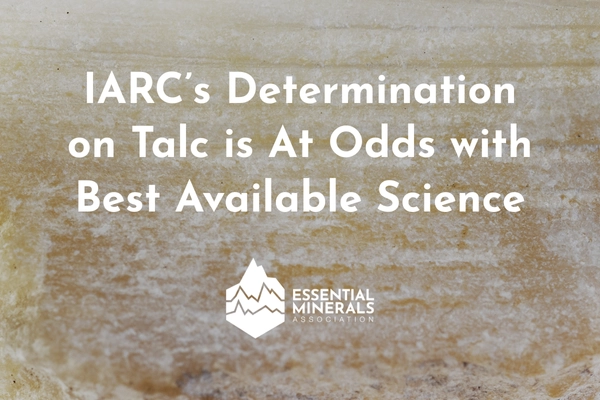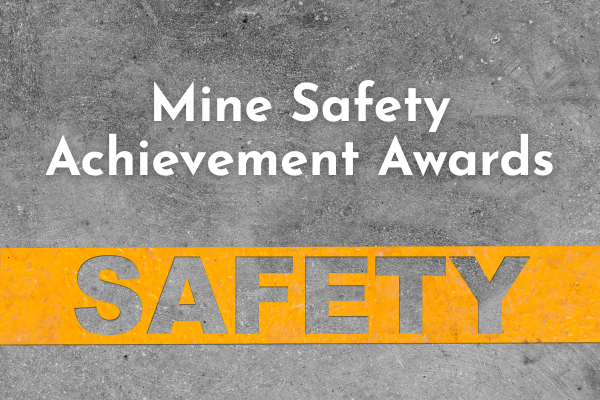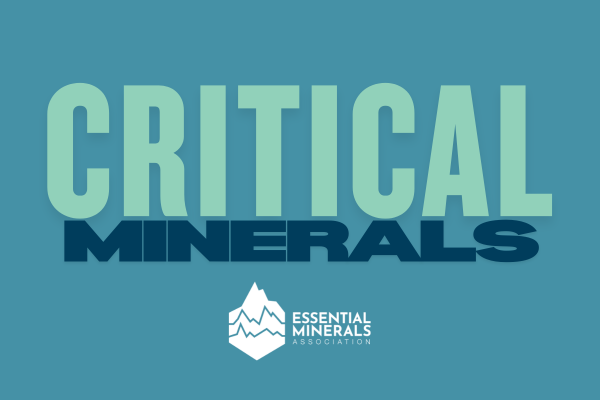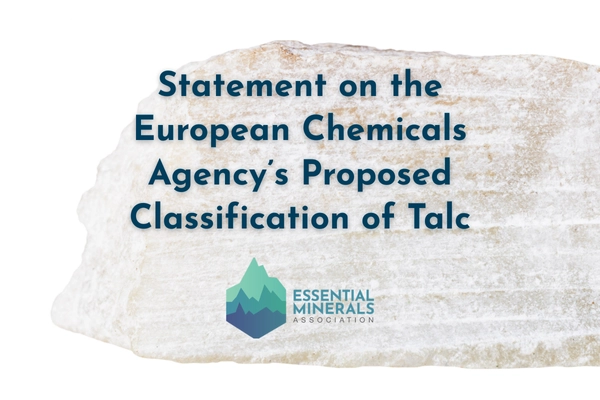August 19, 2025
August 19, 2025

Arlington, VA, August 19, 2025 – The Essential Minerals Association (EMA) disagrees with the International Agency for Research on Cancer’s (IARC) recently finalized Monographs Volume 136: Talc and Acrylonitrile. The working group that met in June 2024 concluded that talc is “probably carcinogenic to humans (Group 2A) on the basis of limited evidence for cancer in humans, sufficient evidence in experimental animals, and strong mechanistic evidence in human primary cells and experimental systems (Stayner, et al., 2024).” The strongest available evidence across multiple fields of study clearly demonstrates that talc does not cause cancer.
EMA’s reaction is based on the following observed deficiencies with the IARC meeting and its conclusion:
Talc is an important mineral used in products throughout the world, and the output of the IARC working group brings unnecessary confusion and misunderstanding to this essential mineral. The overwhelming weight of scientific evidence does not support IARC’s conclusions. If the agency were to utilize the best available science, it would be abundantly clear that talc does not cause cancer.
#
The Essential Minerals Association is the representative voice for companies that extract and process a vital and beneficial group of raw materials and minerals, which are the essential ingredients for many of the products used in everyday life. EMA ensures that the voices of its member companies and the socio-economic benefits they provide – from mining to end-use products – are heard by government leaders as well as the general public. Visit essentialminerals.org to learn more.
References:
Stayner, L., Carreón-Valencia, T., Demers, P., Fritz, J., Sim, M., Stewart, P., et al. (2024). Carcinogenicity of talc and acrylonitrile. The Lancet Oncology. https://doi.org/10.1016/S1470-2045(24)00384-X
International Agency for Research on Cancer. (2010). Volume 93: Carbon Black, Titanium Dioxide, and Talc. IARC Monographs on the Identification of Carcinogenic Hazards to Humans.
Boon, D., Goodman, J., Colonna, K., Espira, L. & Prueitt, R. (2024). A systematic review of the epidemiology evidence on talc and cancer. Critical Reviews in Toxicology, 54(6), 394-417. https://doi.org/10.1080/10408444.2024.2351081
National Toxicology Program. Toxicology and carcinogenesis studies of talc (CAS No. 14807-96-9) (non-asbestiform) in F344/N rats and B6C3F1 mice (inhalation studies). Natl Toxicol Program Tech Rep Ser 1993; 421:1-287.
Prueitt, R., Drury, N., Shore, R., Boon, D. & Goodman, J. (2024). Talc and human cancer: a systematic review of the experimental animal and mechanistic evidence. Critical Reviews in Toxicology, 54(6), 359-393. https://doi.org/10.1080/10408444.2024.2349668
Mundt, K. A., Santamaria, A. B., Thompson, W. J., Bates, C. A., Boles, C., Dotson, G. S., & Yong, M. (2022). Carcinogenicity of Poorly Soluble Low Toxicity Particles: Commentary on Epidemiology as a Risk Assessment "Reality Check". Frontiers in public health, 10, 920032. https://doi.org/10.3389/fpubh.2022.920032
Ghio, A. J. (2025). Talc, Pleurodesis, and Cancer. Am. J. Respir. Crit. Care Med, 211(2), 295-296. https://doi.org/10.1164/rccm.202407-1376RL
International Agency for Research on Cancer. (2025). Volume 136: Talc and Acrylonitrile. IARC Monographs on the Identification of Carcinogenic Hazards to Humans.
ECHA. Opinion proposing harmonised classification and labelling at EU level of Talc (Mg3H2(SiO3)4) (2025). Retrieved 2025, from https://echa.europa.eu/documents/10162/03b74f7b-10ca-3e74-514b-e7f2b24c98ec.

September 18, 2025

August 25, 2025

August 19, 2025